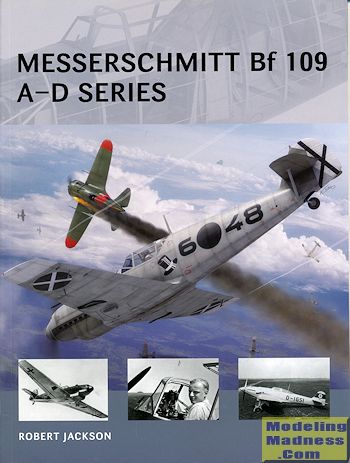 One of
the most widely built combat aircraft was the Bf-109. This was only surpassed by
the IL-2 and if one takes into account trainers, the Po-2 will have beaten them
both in terms of sheer numbers. Some consider the Jumo engine 109s to not be the
full production type. The author is amongst those who think that the full
production 109 started with the 109E, but the truth is that over a thousand of
these early planes came off the production line.
One of
the most widely built combat aircraft was the Bf-109. This was only surpassed by
the IL-2 and if one takes into account trainers, the Po-2 will have beaten them
both in terms of sheer numbers. Some consider the Jumo engine 109s to not be the
full production type. The author is amongst those who think that the full
production 109 started with the 109E, but the truth is that over a thousand of
these early planes came off the production line.
The 109 came about through the usual machinations of the German military
and aircraft industry, a place where if someone did not like you, then your
products would not be built. So it was with Willy Messerschmitt and Erhard Milch.
Milch was in charge of aircraft procurement in the early years and did not like
Messerschmitt. If Messerschmitt had not garnered the favor of Goering, the 109
may never have seen the light of day.
The author states that there are a few myths about the early 109 that
have been repeated over and over again. One is that the aft fuselage was weak
and that it would easily break away in hard maneuvers. Combat showed that not to
be the case, yet German pilots were often wary of putting any stress on the
plane. Another is that the landing gear was weak and though not like the gear of
other planes, it was just as strong as on aircraft like the Hurricane or P-40,
though its narrow track did require a bit more attention to things.
The 109 was Messerschmitt's first fighter as previous to this he had
only built civil aircraft and racing planes. He was quite a stickler for saving
weight as that meant improving performance. What really set his designs apart
was the four place Bf-108, an aircraft that was much appreciated by those who
flew it and it was this design that carried over to the 109.
The type was hampered from the beginning by an engine that did not
produce the sort of power that was desired. The Jumo 210 was supposed to provide
700 hp and yet the production versions were only capable of 640 hp. While engine
power improved slightly as the different variants were produced, it was realized
that it could never get any better and a switch was later made to the Daimler
Benz that was used in the 109E.
The aircraft saw extensive service in the Spanish Civil War and its
introduction was able to put the Nationalists on an even par with the
Republicans in the air. Though not superior to the Soviet I-16 that was flown by
Republican pilots, it did have its plusses which included good diving speed so
the dive and zoom tactics were used with much success by German pilots. Once
WWII got underway, the type was quickly replaced by the superior 109E, though
the D version was used in Poland and actually produced a single ace on the type
during that campaign.
The book covers the background of the designer as well as the results of
the fly-off that got the 109 its first production contracts. It then goes into
the differences in the variants and it covers its operations during the Spanish
Civil War. A chart of all the pilots who became aces during that conflict is
provided as well as information on prototypes and camouflage schemes. There are a number
of excellent photos of the aircraft and some equally nicely done artwork. As
usual, there is a large cutaway on the back two pages. A great read and highly recommended.
March 2015
For more on the complete line of Osprey books,
visit http://ospreygrp.com. In the US, it is
Osprey Direct at 44-02 23rd St, Suite 219, Long Island City, NY 11101., where you can
get a catalogue of available books.
If you would like your product reviewed fairly and
fairly quickly, please
contact
the editor or see other details in the
Note to
Contributors.
 One of
the most widely built combat aircraft was the Bf-109. This was only surpassed by
the IL-2 and if one takes into account trainers, the Po-2 will have beaten them
both in terms of sheer numbers. Some consider the Jumo engine 109s to not be the
full production type. The author is amongst those who think that the full
production 109 started with the 109E, but the truth is that over a thousand of
these early planes came off the production line.
One of
the most widely built combat aircraft was the Bf-109. This was only surpassed by
the IL-2 and if one takes into account trainers, the Po-2 will have beaten them
both in terms of sheer numbers. Some consider the Jumo engine 109s to not be the
full production type. The author is amongst those who think that the full
production 109 started with the 109E, but the truth is that over a thousand of
these early planes came off the production line.